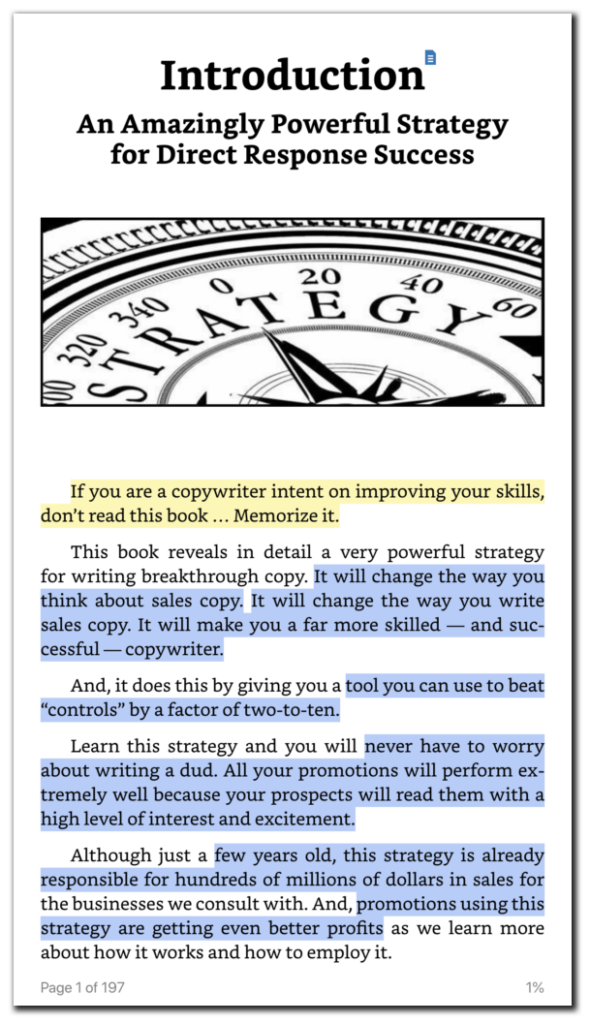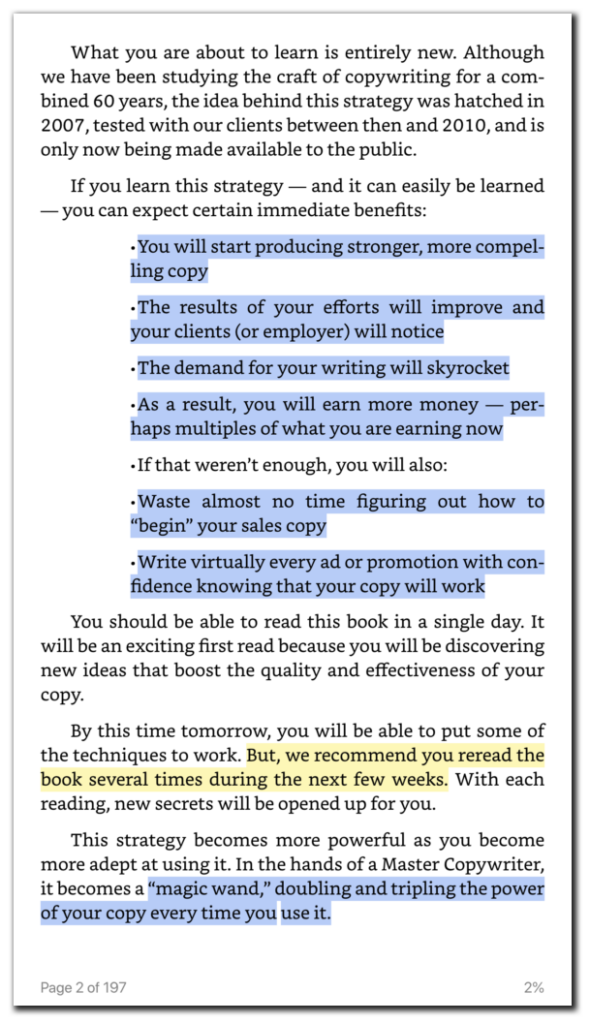This morning, I sat down to reread one of my favorite copywriting books, Great Leads by Michael Masterson and John Forde.
But this time, it was different:

I didn’t just read the book to learn from it or refresh my memory.
Instead, I automatically scanned the copy and highlighted all the parts where the author painted the dream, and spoke about the desires of his audience that got them excited to read the book.
I went through page after page, and kept highlighting the parts where he either painted the dream (in blue) or twisted the knife (in red):

(the Kindle app on the phone lets you highlight in different colors, which is super useful for this exercise)
Within minutes, I had 10 pages of highlights that were screaming to be recorded in a research document, never to be forgotten.
I pulled out my laptop, opened a new document, and copied all the interesting parts into it:

All of a sudden, I had a page full of compelling research that I could use in my copy, to produce stronger, more compelling copy in the future.
From phrases like “waste no more time figuring out how to “begin” sales copy”, “forge an instant connection with your reader” and “never have to worry about writing a dud” I could pull article ideas, headlines, sales narratives, and more!
Before we go any further, let’s make two things clear:
- This technique wouldn’t be a replacement for talking to my readers and customers (nothing beats finding the exact language of your readers), it would be another great tool to have in my research toolbox.
- I would never steal the exact copy from other copywriters – but I could broaden my vocabulary and see patterns in the problems and desires of my audience.
I realized that I could use the very same technique on any copywriting book in my industry, as well as any sales page, sales email, opt-in copy… Any piece of copy out there.
I could also effortlessly pull interesting stories, facts, statistics, anecdotes, and even objections of my audience out of everything I read.
This way, every time I’d read copy about copywriting, I’d also automatically understand my market better and become a better copywriter.
As soon as I discovered this technique, I knew I wanted to share it with you.
I opened a Google Document and started writing this blog post.
I just needed to find a sticky name for this idea, so I could refer to it in the future, and so my clients would remember it.
That’s how Copy Scan was born.
Copy Drill: How to use Copy Scan to write better copy
The next time you read a book, article, e-book, sales page or e-mail related to your industry, don’t just read it.
Instead, scan the copy for:
- Problems of your audience (to twist the knife)
- Desires / goals of your audience (to paint the dream)
- Their objections, opinions and beliefs
- Leads and buried leads
- Stories and anecdotes
- Headlines
- …and any other copywriting elements you want to get better at
Highlight these – and save them into a research document for later use.
This way, every time you sit down to read a piece of copy, you’ll learn from it, increase the amount of research you have, and become a better copywriter (as you learn how to recognize copywriting frameworks in the copy).
As you go on your highlighting rampage, here’s one extra tip to keep in mind:
Highlight the parts of copy that trigger an emotional response in you.
- If a promise of the author excites you… It’s likely a desire that your readers have as well, which will excite them.
- If you can relate to a story the author shares, and you can feel their pain as you read it, you’ve uncovered a painful problem of your audience.
- If you can’t stop reading and crave to find out more about an idea, you’ve found places where the author successfully built suspense and anticipation.
- If you think “wow, I didn’t know that!”, you’ve identified surprising or counterintuitive facts and information.
- If you think “that’s interesting!”, you’ve identified interesting statistics, facts or stories.
I recommend you to read and highlight the copy first – then take some time to move all the highlights into a dedicated research document.
If you have an assistant, he/she could even do this for you – and save you a few hours of work down the line.
So go on, play around with this idea – and let me know how it goes in the comments!
Want to write copy that converts better than cold lemonade on a hot summer day?
If you liked this copywriting drill, you probably won’t hate the 7 more copywriting drills I have in store for you.
My readers that went through these secret drills said that “they help them see their copy in ways they’ve never seen it before”…
But I’ll let you experience that for yourself.
If you want to write stronger, more compelling copy that actually connects with your readers and makes them excited to buy from you…
…or if you just want to have the most profitable lemonade stand in the country…
…join The Copywriting Hell Week, my 7-day copywriting challenge, by leaving your name and email in the orange box below.
You won’t hate it.
-Primoz
Awesome blog post Primoz.
I am guilty of just reading a book and forgetting most of its contents. Consuming instead of implementing.
This seems like is a great way to dissect and get the most out of every book you read, especially if you are someone who wants to write high level copy for your business.
I can’t wait to go through books I’ve read before with a different ‘lens’ instead of re-reading mindlessly. DELIBERATE or INTENTIONAL reading. I love it.
I’m going to start re-reading The Boron Letters with a ‘finding the lead’ lens to give me new ideas on how I could potentially GRAB the attention of my audience with interesting stories so they are dying to carry on reading and devour every piece of content I publish (something you do brilliantly in Copywriting Hellweek).
Thanks for the advice,
Looking forward to the next post.
Adam
I love the attitude Adam!
You’ll learn so much more about copywriting by actually studying everything you read as copy :).